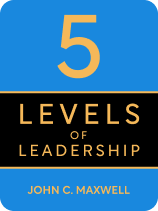

This article is an excerpt from the Shortform book guide to "The 5 Levels of Leadership" by John C. Maxwell. Shortform has the world's best summaries and analyses of books you should be reading.
Like this article? Sign up for a free trial here .
What is Level 4 leadership? How does it differ from the earlier levels?
At Level 4 leadership, you shift gears from being a producer to a developer of people. Developing people entails a lot of maturity and commitment, which is why only leaders with significant leadership experience can reach this level.
Keep reading to learn about Maxwell’s Level 4 leadership (also known as people development or empowerment-based leadership).
What Is Level 4 Leadership?
People are an organization’s greatest asset. Tap into their potential and bring out the best in them, and you also bring out the best in the organization. This is why at Level 4, you shift your gears from being a producer to a developer of people. The time you spend developing others will pay off not just by multiplying production but also by giving you the greatest fulfillment.
Pros of People Development
The upsides of developing people are:
1. It puts you ahead of the pack. Businesses have a fairly even playing field when it comes to physical resources—they can purchase the same equipment and continuously upgrade them to stay in step with their competitors. But what businesses can’t copy is their competitor’s people. If you invest in developing skilled, dedicated employees, your organization will come out ahead of the competition.
2. It makes growth sustainable. If you had to go on sabbatical, would your team be able to stay productive? Would they be able to keep going at the same pace without you around? If your answer is no, then that means that production lives and dies with you—and that’s no way for an organization to grow. When you don’t train others to become leaders, you limit the organization’s potential. Your productivity may bring your organization success, but it’s your development of other leaders that will sustain it. Learn to recognize people who can do what you’re doing, then coach, encourage, and inspire them to take on more responsibility.
3. It empowers others to unlock their potential. There are two ways people can be limited as leaders: Either they’re a leader only in name and lack the drive or skill to empower their people, or they’re driven and skilled but choose not to share responsibility with anyone else. Both put a cap on an organization’s growth.
If you’ve already proven your competence as a Level 3 leader, you need to start recognizing that sharing your load gives others the opportunity to fulfill their own leadership potential. This will prove beneficial not only to your people, but also to the organization (which will have more competent leaders) and to you (as sharing the load will lighten the weight of your responsibility). Throw everything you have into developing your people, from providing training to giving them the right tools and environment to grow, but also be clear that you can’t do the work for them—they need to commit to the process.
4. It gives you time for more important work. When you’re caught up in the daily grind, you don’t have time to think about ways to make an organization better. But when you develop leaders and cede some responsibilities over to them, you free up some quality thinking time, which you can then use to refine the vision, improve your strategies, and find more ways to grow your organization. It’s a paradox: By letting go of something, you gain something greater.
It’s natural to feel hesitant when you’re considering sharing the load, but it’s the only way forward. Ease your worries by using the 80 percent rule: Entrust tasks to those who can do them at least 80 percent as well as you do. Done is better than perfect, so as a leader, you’ll need to let pragmatism rule.
5. It makes you feel fulfilled. Developing people isn’t one-sided. While others will benefit from your guidance, you’ll also get a great amount of joy, satisfaction, and a sense of community from helping others.
Cons of People Development
Developing people entails a lot of maturity and commitment on your part. Here are some of the challenges you’ll need to overcome in Level 4:
- You have to think beyond yourself. Level 4 leadership requires you to give up self-centeredness. You have to start thinking about other people, shifting your mindset from, “How can I get ahead?” to “What can I do to help others get ahead?”
- You need to let go of insecurity. Insecure leaders are constantly worried that someone will replace them and so they’re not interested in developing other people. To determine if insecurity is holding you back from being a Leader 4 leader, reflect on the following areas:
- Ego. Do you happily listen to other people’s ideas? Accept when their ideas are better than yours? Give credit to others when your team experiences success? Take accountability for your team’s failings? If your answer is no, then you need to learn to keep your ego in check.
- Control. Do you micromanage? Insecure leaders are very controlling because they’re worried that their people will make mistakes, but you can’t break new ground if you’re unwilling to take risks. Change your mindset and think of mistakes as learning tools that can aid in your team’s growth.
- Trust. Insecurity breeds distrust, and it’s hard for a team to do good work when there’s an atmosphere of distrust. You can’t take risks and make big strides if you’re always worried that someone will drop the ball. And once you lose trust, it’s very hard to get back.
- Example: Maxwell’s daughter Elizabeth was a cheerleader and as a flyer, she was always thrown in the air. She could perform high-flying stunts because she had complete trust that her teammates would catch her—until an inattentive teammate didn’t. After that experience, she felt tentative whenever she was thrown into the air.
- You need to choose the harder route. Training other people requires a lot of time and energy, so it’s often easier to just do things yourself. While this seems more practical and you might get things done more quickly, it’s a short-sighted view. As a Level 4 leader, you need to think long-term. Buckle down and put in the work of developing others, no matter how challenging it is, because it will pay off in the long run.
- You need to be committed. Level 4 leaders can’t coast. They have to perform consistently and excellently, build and train a team, empower other potential leaders, and be invested in their development. It’s hard work that requires 100 percent from you.
Maximizing People Development
Only those with leadership experience can develop other leaders. That means you need to first work your way through Levels 1 to 3 before you can implement these level 4 leadership best behaviors:
1. Recruit the best people. You can’t create a winning organization if you don’t have strong players who are willing to grow and who are a good fit for the organization.
- To gauge people’s potential, consider:
- Chemistry—Do you like this person enough to invest time in mentoring him? Will he get along with the rest of the team?
- Character—Can this person align his actions with his intentions?
- Capacity—Can this person handle stress? Does he have the necessary skill, thinking ability, leadership, and positive attitude? Can you motivate and train him so that he can reach his potential?
- Contribution—Will this person go above and beyond his job description? Will he help the people around him perform better?
- Know exactly what kind of person you’re looking for.
- Example: If you’re a baseball coach and your team isn’t winning because you don’t have good hitters, you won’t go out and recruit a great pitcher, even if he’s the best you’ve ever seen. A pitcher is not what the team needs—you need a hitter.
2. Know where to put them. Aside from recruiting the people that your team needs, you also need to position them strategically. It’s a process, so take your time and don’t be afraid to move people around. This is similar to one of the best behaviors in Level 3, which is about making sure that you put people in their “spots” to maximize their strengths and leverage their weaknesses.
- Example: Red Aurbach, who’s won several NBA championships as coach, general manager, and front office president, says that his team’s success didn’t come from putting the best five players on the court. It was from putting the five players who could work together best.
3. Be an example. Model how to lead by being authentic, serving others, continuing to grow, aiming for excellence, and working with passion and purpose.
4. Give your people the tools to do their jobs well. Don’t just tell them what to do. You can help them grow into their role by following these steps:
- Step 1—Be competent at the job yourself.
- Step 2—Show them how to do the job.
- Step 3—Let them do the job while you’re there to coach them.
- Step 4—Leave them to do the job. This is where empowerment comes in. You trust and believe in them, while holding them accountable.
- Step 5—They come full circle and now show someone else how to do the job.
5. Don’t just focus on their work life. There’s more to life than work. As a Level 4 leader, you need to recognize the importance of helping your people develop life skills so that they’ll achieve success in all areas of their life. Evaluate any weaknesses and help your people overcome them by:
- Assessing—Are there any holes in this person’s life skills? Are there any negative influences in this person’s life? In what areas does this person seem to need help? If you’ve established yourself as a Level 2 leader, you should be able to spot areas for improvement.
- Challenging—If you’ve gained their permission to lead them and have modeled success, they’ll be more open to accepting challenges to help them improve. These challenges can include reading books, attending conferences, and meeting with you for mentoring.
- Supporting—Keep an open-door policy, letting people know that they can come to you for mentoring.
6. Gauge where they are on their leadership journey. How can you tell if your people are ready to handle being empowered? One way to measure it is by determining how independent they are. When something happens, do you:
- Have them report to you and you decide what to do?
- Have them report to you, along with their recommendations?
- Have them inform you what they plan to do and wait for your go signal?
- Have them inform you what they plan to do and give them the freedom to go ahead unless you say no?
- Trust them to take action then let you know what they did?
- Trust them to take action without your involvement?
Your goal is to be able to trust them to take action without your involvement.
Applicable Laws of Leadership
The following are the relevant Laws of Leadership for those in Level 4:
- Leaders Develop Leadership Ability Over Time. Just as it has taken time for you to develop as a leader, so too will it take time for your people to grow. Don’t rush the process.
- Leaders Serve Others. Shift your mindset from pursuing your own success to pursuing the success of your people.
- Leaders Build a Leadership Team. As a leader, you need an inner circle to help you achieve your highest goals. Take a look at the people who surround you—if those closest to you don’t have what it takes to help you achieve big things, then start developing people who can go on your journey with you.
- Leaders Empower Others. You can’t be a leader if you’re selfish and insecure, wanting to hog the limelight. Overcome your insecurities and empower those who have what it takes to help the organization succeed.
- Leaders Lead Leaders. If your efforts as a Level 3 leader result in increased productivity for the organization, imagine what would happen if your work was multiplied by the leaders you develop.
- Leaders Are Followed, Visions Aren’t. The higher your level on the leadership journey, the more influence you have and the easier it will be to get people on board. At Level 4, you inspire your people by showing them that you believe in them and their potential.
Moving-Up Mantras
As a leader who’s focused on people development, you’ve already at a very high level, but you can still go higher. These beliefs can help you reach Level 5:
- Leadership has a compounding effect. Your goal as a leader is to develop more leaders. If you accomplish this, your success will reach far and wide—you’ll help those you nurture and, consequently, all those they’ll help in turn.
- Leaders thrive in a leadership culture. Fostering a leadership culture begins with you: You must model it and teach it consistently. You must also guide emerging leaders through the process by helping them plan and execute, giving them feedback, and rewarding good leadership. This encourages people to step up to the plate.
- Developing leaders is a way of life, not a 9-to-5 job. The world has so many needs, and the only way we can even begin to meet them is by developing leaders who can show the way. This is why developing leaders goes beyond your organization—it’s something you should do even outside of your job to truly have an impact on the world.
Your To-Do List
Here are some practical tips to help you as you develop other leaders:
- Stay open to growth. Just as you’re taking emerging leaders on a journey, you’re also going through your own journey, so you should keep learning. And just as you attract people who are like you, you also reproduce people who are like you, so remain teachable and willing to learn.
- Embrace people, embrace the process. Make a decision to commit to people development because you genuinely want to help people and think it’s worth it, not because you want to change other people to suit you.
- Overcome your insecurities. If you find that your ego, desire for control, or distrust are getting in the way of developing people, then work through them by talking to a friend or a counselor.
- Prioritize people with potential. Many leaders find themselves spending much of their time managing the “problem children” in their team—the bottom 20 percent who may be underperformers or troublemakers. Switch it around and instead start focusing your attention on the top 20 percent, because they are the key to growth. Once you’ve identified those with the most potential, start dedicating as much as 50 percent of your time to developing them.
- Make it a clear-cut process. While Level 4 leaders change and tailor their mentorship according to people’s skills and personalities, it’s just as important to have some clear guidelines that are applicable to everyone:
- Mentorship should take place every day.
- It should be quantifiable—there must be some verifiable measures of success.
- It should motivate them.
- It should tap into your strengths. You can’t teach them something you’re not good at. Encourage them to find other mentors for areas that aren’t in your areas of strength.
- It should fit in with their “why.”
- Mentor progressively. People will benefit more from seeing you in action than just having a conversation with you. Go through it step-by-step: Show them how to do the job, let them do the job while you’re there to coach them, then empower them to do the job themselves.
- Make the process emotionally engaging. Show people how much you love what you do. Bringing that positive energy encourages and inspires others to do their best.
- Be open, humble, and transparent. When your people feel like they can approach you, they’ll be more open to learning and taking risks.

———End of Preview———
Like what you just read? Read the rest of the world's best book summary and analysis of John C. Maxwell's "The 5 Levels of Leadership" at Shortform .
Here's what you'll find in our full The 5 Levels of Leadership summary :
- How to go from being a leader in title only to a true leader
- How to create a legacy as a leader
- Why you have to help others move up after you've evolved as a leader






